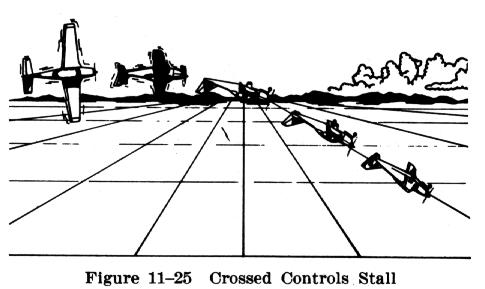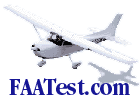| Crossed Control Stall
The objective of this demonstration maneuver is to show the effect of improper control technique and to emphasize the importance of using coordinated control pressures whenever making turns. This type stall occurs with the controls "crossed" - that is, aileron pressure applied in one direction and rudder pressure in the opposite direction. In addition, when excessive back elevator pressure is applied a
"cross control stall" may result (Fig. 11-25).
The addition of inside rudder pressure will cause the speed of the outer wing to increase and thus create greater lift on that wing. To keep that wing from rising and to maintain a constant angle of bank, opposite aileron pressure would need to be applied. The added inside rudder pressure will also cause the nose to lower in relation to the horizon. Consequently, additional back elevator pressure would be required to maintain a constant pitch attitude. The resulting condition, then, is a turn with rudder applied in one direction, aileron in the opposite direction, and excessive back elevator pressure - a pronounced cross control condition. Since the airplane is in a skidding turn during the crossed
control condition, the wing on the outside of the turn speeds up and produces
more lift than the inside wing; thus the airplane starts to increase its bank.
The down aileron on the inside of the turn helps drag that wing back, slowing it
up and decreasing its lift, which requires more aileron application. This
further causes the airplane to roll. The roll may be so fast that it is possible
the bank will be vertical or past vertical before it can be stopped.
Before demonstrating this stall, the pilot should clear the area for other air traffic while slowly retarding the throttle. Then the landing gear (if retractable gear) should be lowered, the throttle closed, and the altitude maintained until the airspeed approaches the normal glide speed. Because of the possibility of exceeding the airplane's limitations, flaps should not be extended. While the gliding attitude and airspeed are being established, the airplane should be retrimmed. When the glide is stabilized, the airplane should be rolled into a medium banked turn to simulate a final approach turn which would overshoot the centerline of the runway. During the turn, excessive rudder pressure should be applied in the direction of the turn but the bank held constant by applying opposite aileron pressure. At the same time increased back elevator pressure is required to keep the nose from lowering. All of these control pressures should be increased until the airplane stalls. When the stall occurs, recovery is made by releasing the control pressures and increasing power as necessary to recover. In a cross control stall, the airplane often stalls with little warning. The nose may pitch down, the inside wing may suddenly drop, and the airplane may continue to roll to an inverted position. This is usually the beginning of a spin. It is obvious that close to the ground is no place to allow this to happen. If recovery can be made before the airplane enters an abnormal attitude (vertical spiral or spin), it is a simple matter to return to straight and level flight by coordinated use of the controls. If a recovery cannot be completed before the airplane reaches an abnormal or inverted attitude, the control pressures must be released to break the stall and the roll allowed to continue until the airplane reaches straight and level flight. Applying power when the nose is pointed toward the ground will result in a greater loss of altitude - with the possibility of impacting the ground if the stall were to occur during an actual landing approach. The pilot must be able to recognize when this stall is imminent
and must take immediate action to prevent a completely stalled condition. It is
imperative that this type of stall not occur during an actual approach to a
landing, since recovery may be impossible before the airplane strikes the
ground.
|

